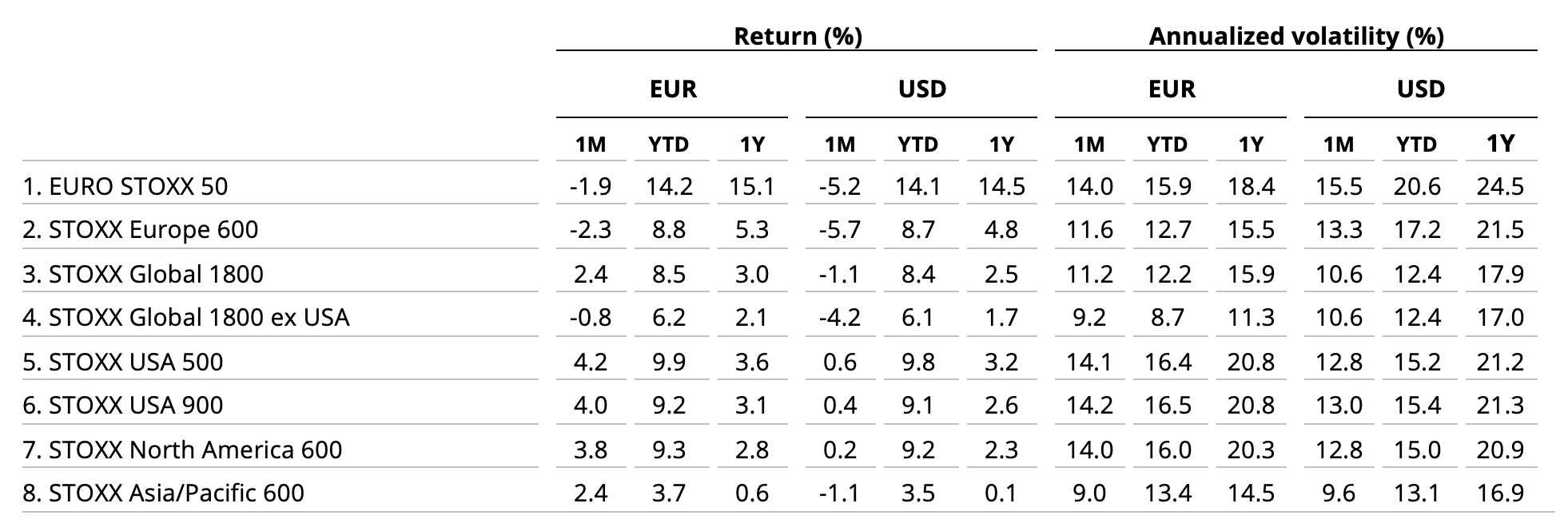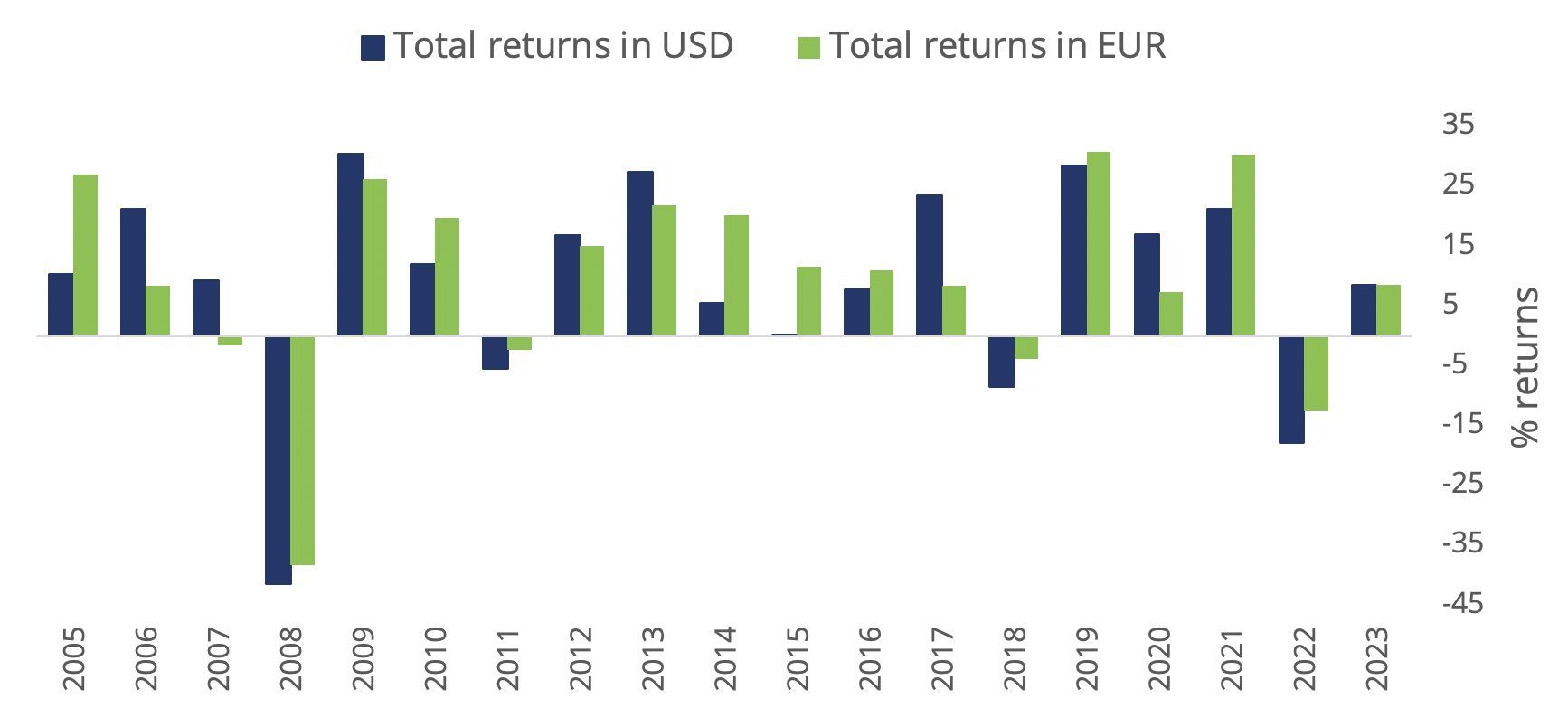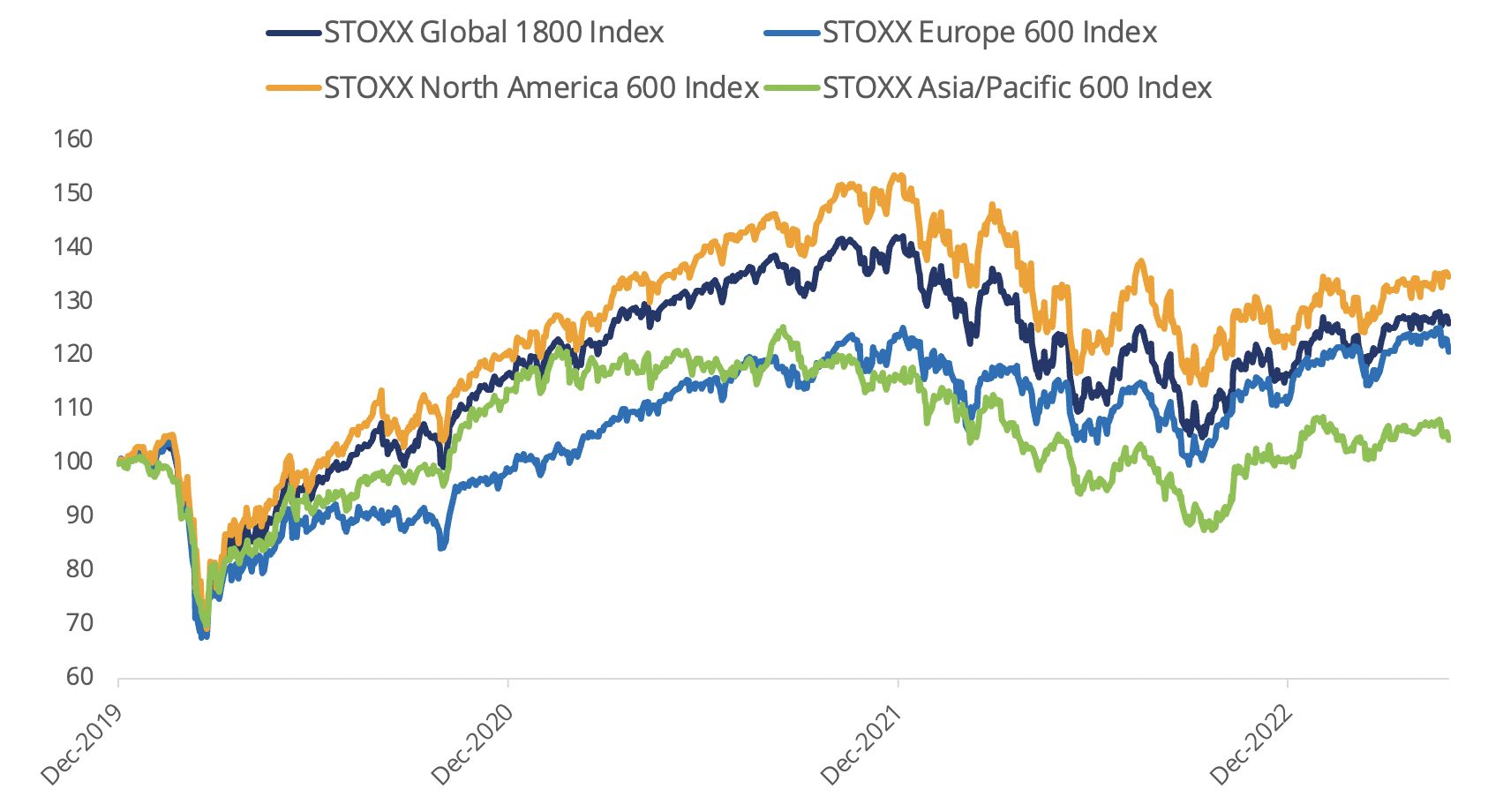
Global equity indices retreated in May, dragged lower by European and Asian shares. In the US, better-than-expected earnings from technology companies overshadowed concerns about a government default and ongoing interest rate hikes.
The STOXX® Global 1800 index lost 1.1% last month when measured in dollars and including dividends1. The benchmark slid 17.9% in 2022, its worst year since 2008, as central banks pressed ahead with higher rates to fight runaway inflation. The index added 2.4% in euros after the greenback rose 3.4% against the common currency. The STOXX® World AC index dropped 0.9% in dollars.
The Eurozone’s EURO STOXX 50® fell 1.9% in euros in the month, while the pan-European STOXX® Europe 600 shed 2.3%.2 The STOXX® North America 600 climbed 0.2% in dollars, while the STOXX® USA 500 rose 0.6%. The STOXX® Asia/Pacific 600 fell 1.1% in dollars.
Figure 1: STOXX Benchmark indices’ May risk and return

Figure 2: STOXX Equity World indices’ May risk and return

Germany’s DAX® dropped 1.6% in the month. MDAX®, which gauges the performance of German mid-caps, lost 4.7%.
| For a complete review of all indices’ performance last month, visit our May index newsletter |
Germany reports recession for first quarter
A strong April jobs report in the US bolstered expectations that the Federal Reserve may raise interest rates further, while concern grew that the country would breach its debt ceiling and default on payments. The Eurozone’s economy, meanwhile, appears to be less strong, with Germany reported during May to have fallen into a recession in the first quarter.
Back in the US, NVIDIA Corp. topped a USD 1 trillion valuation after the chipmaker posted revenue and earnings that surpassed estimates, and forecast sales that were 50% above analysts’ projections.
Figure 3: Annual % returns for STOXX Global 1800 index

Figure 4: Select STOXX regional indices’ returns since Jan. 1, 2020

Volatility rises
The EURO STOXX 50® Volatility (VSTOXX®), which tracks EURO STOXX 50 options prices, rose to 20 at the end of last month from 17.4 in April. A higher VSTOXX reading suggests investors are paying up for puts that offer insurance against stock price drops. The VDAX-New®, which measures volatility in German equities, climbed to 19.6 from 17.4 in April.
Energy drops, technology jumps
All but three of 20 Supersectors in the STOXX Global 1800 had losses in May, led by a 9.4% drop for the STOXX® Global 1800 Energy index. At the other end of the table, the STOXX® Global 1800 Technology index jumped 10.1%.
Twenty-two of 25 developed markets tracked by STOXX retreated in May when measured in dollars. The STOXX® Developed World index slid 0.9% in dollars.
Thirteen of 20 national developing markets tracked by STOXX dropped in the month on a dollar basis. The STOXX® Emerging Markets index fell 1% in the US currency.
Factor investing
On a global basis, all but one factor style — Quality — underperformed the benchmark in May, according to the STOXX Factor indices. Size (small-caps) was the weakest signal.
Figure 5: STOXX Factor (Global) indices’ May risk and return characteristics

Climate benchmarks
Among climate benchmarks, the STOXX® Global 1800 Paris-Aligned Benchmark (PAB) (-0.01%)3 and the STOXX® Global 1800 Climate Transition Benchmark (CTB) (-0.2%) outperformed their benchmark in the month. The PAB and CTB indices follow the requirements outlined by the European Commission’s climate benchmarks regulation.
The STOXX® Willis Towers Watson World Climate Transition Index was unchanged in the month. The STOXX Willis Towers Watson Climate Transition Indices (CTIs) employ a unique Climate Transition Value at Risk (CTVaR) methodology that quantifies the anticipated impact of an economic transition on equity valuations. The CTIs look beyond carbon emissions and make a forward-looking, bottom-up evaluation of asset repricing risks in a decarbonization pathway.
Among the STOXX Low Carbon indices, the EURO STOXX 50® Low Carbon (-2.2%) underperformed the EURO STOXX 50 by 29 basis points in May. Elsewhere, the STOXX® Global Climate Change Leaders (-1.2%), which selects corporate leaders that are publicly committed to reducing their carbon footprint, trailed the STOXX Global 1800 index by 14 basis points last month.
Sustainability indices
The STOXX® Global 1800 ESG-X index lost 0.6% in the month. The STOXX® ESG-X indices are versions of traditional, market-capitalization-weighted benchmarks that observe standard responsible exclusions.
Within indices that combine exclusions and ESG best-in-class integration, the EURO STOXX 50® ESG index lost 1.1% in May. Germany’s DAX® 50 ESG index (-1.7%), which excludes companies involved in controversial activities and integrates ESG scoring into stock selection, slightly underperformed the benchmark DAX.
Among other STOXX sustainability families, the STOXX® Global 1800 ESG Broad Market index fell 0.6% in the month. The STOXX ESG Broad Market indices apply a set of compliance, product involvement and ESG performance exclusionary screens on a starting benchmark universe until only the 80% top ESG-rated constituents remain.
The STOXX® Global 1800 ESG Target fell 1.5%, the EURO STOXX® ESG Target dropped 1.9% and the DAX® ESG Target lost 0.8%. The STOXX and DAX ESG Target indices seek to significantly improve the benchmark portfolio’s ESG profile while mirroring its returns as closely as possible. Through a series of constraints, the indices implement an optimization process to maximize the overall ESG score of the portfolio while limiting the tracking error to the benchmark.
The STOXX® Global 1800 SRI slid 1.5%. The STOXX SRI indices apply a rigorous set of carbon emission intensity, compliance and involvement screens, and track the best ESG performers in each industry group within a selection of STOXX benchmarks.
Finally, the DAX® ESG Screened lost 1.3% in the month. The index reflects the composition of the DAX benchmark minus companies that fail to pass norms-based and controversial weapons screenings, meet minimum ESG ratings or are involved in certain business activities considered undesirable from a responsible investing perspective.
Thematic Indices: Artificial intelligence in focus
Among 26 STOXX® Thematic indices, 19 outperformed the benchmark STOXX Global 1800 last month. The STOXX® Global Artificial Intelligence index showed the steepest gain in May (+13.9%), led by its largest constituent, NVIDIA.
Dividend strategies
Dividend strategies underperformed last month. The STOXX® Global Maximum Dividend 40 (-5.8%) selects only the highest-dividend-yielding stocks. the STOXX® Global Select Dividend 100 (-6.9%) tracks companies with sizeable dividends but also applies a quality filter such as a history of stable payments.
Minimum variance
Minimum variance strategies also struggled as investors avoided low-risk shares. The STOXX® Global 1800 Minimum Variance fell 3.4% and the STOXX® Global 1800 Minimum Variance Unconstrained tanked 5.7%.
The STOXX Minimum Variance Indices come in two versions. A constrained version has similar exposure to its market-capitalization-weighted benchmark but with lower risk. The unconstrained version, on the other hand, has more freedom to fulfill its minimum variance mandate within the same universe of stocks.
1 All results are total returns before taxes unless specified.
2 Throughout the article, all European indices are quoted in euros, while global, North America, US, Japan and Asia/Pacific indices are in dollars.
3 Figures in parentheses show last month’s gross returns.



